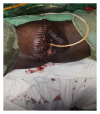The giant condyloma (buschke-löwenstein tumor) in the immunocompromised patient
- PMID: 25328732
- PMCID: PMC4190693
- DOI: 10.1155/2014/793534
The giant condyloma (buschke-löwenstein tumor) in the immunocompromised patient
Abstract
Since Buschke and Löwenstein first described the giant condyloma in 1925 (which subsequently was named Buschke-Löwenstein tumor), there have been scattered reports over the past 90 years describing presentation and different avenues of treatment for patients with this condition. It is well known that immunocompromised individuals are at an increased risk of anogenital disease caused by human papillomavirus (HPV). In this report, we present the management of two HIV positive patients with giant condylomas. Both patients presented with urinary outflow obstruction and sepsis. Though giant condylomas are a rare phenomenon, these two cases underscore the importance of early treatment intervention, especially in the immunocompromised patient.
Figures




Similar articles
-
Giant anogenital tumor of Buschke-Löwenstein in a patient living with human immunodeficiency virus/acquired immunodeficiency syndrome: a case report.J Med Case Rep. 2022 Mar 18;16(1):116. doi: 10.1186/s13256-022-03339-1. J Med Case Rep. 2022. PMID: 35303943 Free PMC article.
-
Buschke-Löwenstein tumor in a human immunodeficiency virus-positive patient: a case report and short literature review.Acta Gastroenterol Belg. 2021 Apr-Jun;84(2):343-345. doi: 10.51821/84.2.343. Acta Gastroenterol Belg. 2021. PMID: 34217186 Review.
-
Perianal giant condyloma acuminatum-buschke-löwenstein tumor: a case report.Case Rep Surg. 2012;2012:507374. doi: 10.1155/2012/507374. Epub 2012 Nov 20. Case Rep Surg. 2012. PMID: 23213594 Free PMC article.
-
Reconstructive surgery in anal giant condyloma: Report of two cases.Int J Surg Case Rep. 2013;4(12):1088-90. doi: 10.1016/j.ijscr.2013.08.020. Epub 2013 Sep 20. Int J Surg Case Rep. 2013. PMID: 24240074 Free PMC article.
-
Giant condyloma acuminatum or buschke-Lowenstein tumor: review of the literature and report of three cases treated by CO2 laser surgery. A long-term follow-up.Anticancer Res. 2002 Mar-Apr;22(2B):1201-4. Anticancer Res. 2002. PMID: 12168925 Review.
Cited by
-
Clinicopathological Findings and Comprehensive Review of Buschke-Lowenstein Tumors Based on a Case Study.J Pers Med. 2024 Aug 22;14(8):887. doi: 10.3390/jpm14080887. J Pers Med. 2024. PMID: 39202078 Free PMC article.
-
Giant anogenital tumor of Buschke-Löwenstein in a patient living with human immunodeficiency virus/acquired immunodeficiency syndrome: a case report.J Med Case Rep. 2022 Mar 18;16(1):116. doi: 10.1186/s13256-022-03339-1. J Med Case Rep. 2022. PMID: 35303943 Free PMC article.
-
Buschke-Löwenstein tumour associated with low-risk human papillomavirus genotypes successfully treated surgically.Postepy Dermatol Alergol. 2019 Feb;36(1):112-114. doi: 10.5114/ada.2019.82831. Epub 2019 Feb 22. Postepy Dermatol Alergol. 2019. PMID: 30858789 Free PMC article. No abstract available.
-
Giant Condyloma Acuminatum in the Genital, Perineal and Perianal Region in a Pediatric Patient. Literature Review and Case Report.Urol Case Rep. 2016 Apr 23;7:14-6. doi: 10.1016/j.eucr.2016.02.003. eCollection 2016 Jul. Urol Case Rep. 2016. PMID: 27335781 Free PMC article.
-
Bleomycin-based electrochemotherapy for the treatment of a Buschke-Löwenstein tumor (perianal giant condyloma) in an HIV-positive kidney transplant recipient: A case report.Oncol Lett. 2022 Nov 7;24(6):466. doi: 10.3892/ol.2022.13586. eCollection 2022 Dec. Oncol Lett. 2022. PMID: 36406182 Free PMC article.
References
-
- Buschke A, Löwenstein L. Über carcinomähnliche condylomata acuminata des Penis. Klinische Wochenschrift. 1925;4(36):1726–1728.
-
- Frei W. About carcinoma similar pointed condyloma on the penis. Archives of Dermatology and Syphilology. 1930;160:109–114. (Ger).
-
- Yaman I, Bozdag AD, Derici H, Tansug T, Reyhan E. Verrucous carcinoma arising in a giant condyloma acuminata (Buschkelowenstein Tumour): ten-year follow-up. Annals of the Academy of Medicine Singapore. 2011;40(2):104–105. - PubMed
LinkOut - more resources
Full Text Sources
Other Literature Sources
Miscellaneous

